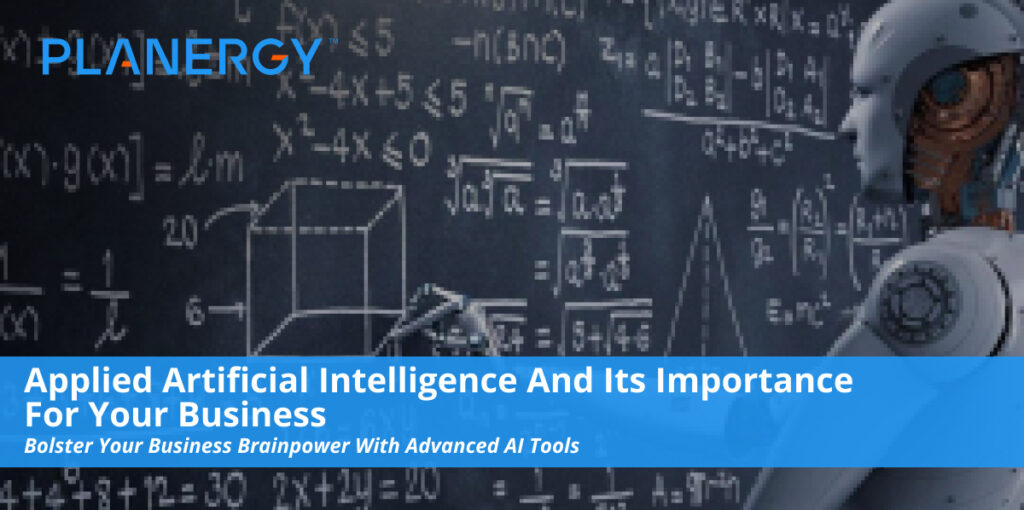In today’s competitive marketplace, the press to achieve maximum productivity, efficiency, accuracy, and value whenever possible has given rise to significant shifts in corporate culture, best practices, and toolsets.
Digital disruption has made computers more important than ever, with computer-powered artificial intelligence moving from the realm of science fiction and into the real world through automation, data science, and a wide array of other tasks supported by and enhanced through machine learning.
Current applications of artificial intelligence (AI) are already transforming the digital and commercial landscapes—and the future holds rich promise for even greater inroads in everything from human-less productivity improvements to insights gleaned from deep data analysis performed with superhuman accuracy and speed.
Understanding how AI is being used—i.e., applied artificial intelligence, or machine intelligences putting their vast potential to use— to drive innovation and process improvement in the modern business world is rapidly becoming essential for any business hoping to compete therein.
How Applied Artificial Intelligence is Different
The phrase “artificial intelligence” has a lot of cultural and symbolic freight attached to it. As a concept, it formally entered the academic arena in Alan
Turing’s seminal 1950 paper, Computer Machinery and Intelligence. But the notion of machines that can think, act, and live—and later, the idea that software empowering these thinking machines operates much the same way as the human mind and, to a lesser extent, spirit—has been with us since antiquity.
From the mechanical soldiers brought to life by Cadmus sowing the dragon’s teeth to the bronze man, Talos, forged by the Greek god Hephaestus to defend Crete, humans have been fantasizing about, and worrying over, the potential creation of truly intelligent artificial life for millennia.
More modern listeners might picture Iron Man‘s JARVIS, HAL 9000 or the Transformers when AI is mentioned, but in the real world, artificial intelligence is simply the ability of a digital device (e.g., a computer or robot) to perform tasks commonly regarded as requiring human intelligence.
Applied artificial intelligence (applied AI) is the use of that same machine intelligence to enhance human performance in a given task—and in some cases, replace and surpass those same humans.
Current applied AI technology isn’t quite at the level of Star Trek, Iron Man, or even 2001, but as anyone who’s ever searched the Internet or asked their phone or home’s smart hub a question knows, companies like Google, Amazon, and Facebook are already putting applied AI to extensive use, creating applications and devices that seem to think for themselves while answering our queries, ordering our dinner, or controlling our smart homes.
And with a projected market presence of $40 billion by 2025, AI applications used to turn big data into bigger profits are certain to grow even more versatile and skilled as investment and innovation enhance their capabilities.
Outside the consumer realm, businesses are increasingly turning to applied artificial intelligence for process improvement, cost savings, and deeper insights for strategic planning.
Early solutions, drawing on lessons learned from Alan Turing’s work, were first developed for widespread use in the 1980s. They have, with the passage of time and growth of technological sophistication, evolved significantly.
What began as bulky, difficult, and often impractical augmentation for decision making leveraging the skills of subject matter experts in rarefied fields evolved over time into tools like optical character recognition (OCR), advanced algorithms that power next-gen data mining, image recognition and tracking, and business software such as enterprise resource planning (ERP) suites and automated procurement software.
By mimicking the human brain while integrating continuous learning and support from actual humans in its processes, applied AI can reduce errors and bias that can creep into human-only decision making. It can also more quickly, and clearly, define optimal objectives, and vastly improve process automation in all areas of business.
Applied AI: Core Concepts
Like its data-deconstructing sibling applied analytics (AA), applied AI is focused on process enhancement, data collection and management, and strategic planning through the use of machine intelligence.
But while AA excels at data mining and the subsequent deep analysis of that data to bring actionable insights to light for improved decision making, AI systems are more complex and nuanced, and focused on decisions made using the insights generated by AA.
Applied AI uses a range of tools in support of accurate and rapid decision-making, including:
- Neural Networks: Computer systems made up of machine learning algorithms modeled after the human nervous system and brain, focused on parsing vast amounts of data to identify useful patterns.
- Deep learning: Algorithms designed to enhance a neural network’s pattern recognition capabilities through optimal:
- Classification: Sorting of labeled data within knowledge bases into sets, patterns, etc. to identify (for example) human faces in photographs or consistent points of delay in a workflow.
- Clustering: identification of patterns and similarities in unlabeled data within knowledge bases, used to add depth and breadth to pattern recognition data obtained from classification of labeled data while also helping the algorithm identify and learn more about anomalies within the data it is tasked with analyzing.
- Regression: Identification and comparison of existing data patterns to postulate potential future outcomes, e.g. customer churn rate, employee turnover, seasonal product demand, etc.
- Reinforcement learning: Over time, algorithms can collect and combine the insights they glean from deep learning to solve more complex tasks and achieve more difficult goals. Reinforcement learning introduces punishment and rewards—reinforcement—for the algorithms, doling out penalties for wrong decisions and plaudits for correct ones. In this way, (and like humans), the algorithms learn to prioritize correct decisions and steadily increase their accuracy and the impact factor of their decision-making skills.
- Natural language processing: Algorithms created to support processing of human language data, as well as searches and data analysis modeled after human speech patterns, rather than strict machine logic.
By mimicking the human brain while integrating continuous learning and support from actual humans in its processes, applied AI can reduce errors and bias that can creep into human-only decision making.
It can also more quickly, and clearly, define optimal objectives, and vastly improve process automation in all areas of business.
How Applied Artificial Intelligence Benefits Businesses
You don’t have to be a data scientist to recognize the potential value of applied artificial intelligence.
Applied AI solutions benefit businesses through:
- End-to-end process automation for greater speed, accuracy, and efficiency.
- Removal of human error and bias while still allowing for strategic human input as required.
- Reduces staff overhead and work hours while freeing employees to focus on high-value tasks that are not yet AI-friendly.
- Continuous process improvement through pattern and activity recognition (e.g., tracking shopper behavior or staff compliance with internal protocols and controls to identify trends, problem areas, and potential opportunities for process refinement)
- Detailed, advanced, and real-time data analytics on demand, from anywhere, provided a cloud solution is used.
- Greater profitability and productivity generated by solving problems too complex and time-consuming for humans alone.
Artificial Intelligence Powers Real-World Gains
Like the old-fashioned human variety, artificial intelligence that isn’t being put to use doesn’t help you solve your toughest problems (or pay the bills).
Making Applied AI part of your digital decision making and planning environment gives you a powerful edge in strategic initiatives, continuous improvement, and problem solving that’ll help you stay ahead of the competition—and on the path to a bright and brainy future for your business.




